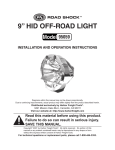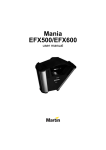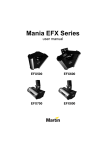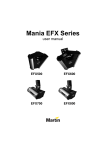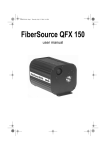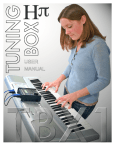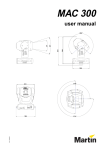Download Harbor Freight Tools 95058 User's Manual
Transcript
Mini Convex HID Fog Lights 95058 INSTALLATION And Operation Instructions Due to continuing improvements, actual product may differ slightly from the product described herein. ® 3491 Mission Oaks Blvd., Camarillo, CA 93011 Visit our website at: http://www.harborfreight.com To prevent serious injury, read and understand all warnings and instructions before use. Copyright© 2007 by Harbor Freight Tools®. All rights reserved. No portion of this manual or any artwork contained herein may be reproduced in any shape or form without the express written consent of Harbor Freight Tools. For technical questions or replacement parts, please call 1-800-444-3353. Specifications High Impact Plastic Body with Tempered Glass Lens, Aluminum Starter Box Construction Power Requirement 12 VDC, 3A (both lights), 5A fuse (included) Bulb Color Blue Bulb Type H3 6000K Total Weight 1.6 lb. Light Dimensions 3-7/8” D x 3-1/4” W x 3” H Save This Manual You will need the manual for the safety warnings and precautions, assembly instructions, operating and maintenance procedures, parts list and diagram. Keep your invoice with this manual. Write the invoice number on the inside of the front cover. Keep the manual and invoice in a safe and dry place for future reference. Safety Warnings and Precautions WARNING: When using equipment, basic safety precautions should always be followed to reduce the risk of personal injury and damage to equipment. Read all instructions before installing or using! 1. Keep your work area clean and well lit. Cluttered benches and dark areas invite accidents. 2. Do not operate automotive accessories in explosive atmospheres, such as in the presence of flammable liquids, gases, or dust. Batteries and automotive accessories may create sparks which may ignite the dust or fumes. 3. Keep bystanders, children, and visitors away from the installation area. Distractions can cause you to lose control. Protect others in the work area from debris such as corrosion materials and sparks. Provide barriers or shields as needed. 4. Do not abuse the Power Cord. Never use the Power Cord to carry the lights. Keep the Power Cord away from heat, oil, sharp edges, or moving parts. Replace damaged Power Cords immediately. Damaged Power Cords increase the risk of fire. 5. Stay alert. Watch what you are doing, and use common sense when operating a automotive accessory. Do not use a automotive accessory while tired or under the influence of drugs, alcohol, or medication. A moment of inattention while operating a automotive accessory may result in serious personal injury. 6. Dress properly. Do not wear loose clothing or jewelry. Contain long hair. Keep your hair, clothing, and gloves away from moving engine parts. Loose clothes, jewelry, or long hair can be caught in moving engine parts. 7. Use safety equipment. Always wear eye protection. Dust mask, nonskid safety shoes, hard hat, or hearing protection must be used for appropriate conditions. ANSI-approved goggles and heavy work gloves should be worn during installation. SKU 95058 For technical questions, please call 1-800-444-3353 Page 8. Use only with vehicles with 12 volt DC electrical systems. 9. Use bolts and included fasteners to properly secure and support the fog lights to a stable platform. This automotive accessory is designed to be installed to a firm structure near the vehicle front grill or bumper. 10. Turn vehicle ignition off before making cable connections. Vehicle’s engine must be cooled down before making cable connections. 11. Disconnect the battery cable before installing lights or changing bulbs. Such preventive safety measures reduce the risk of accident. 12. Keep automotive accessory maintained and clean. Do not use a damaged automotive accessory. Tag damaged automotive accessories “Do not use” until repaired. 13. Use only accessories that are recommended by the manufacturer for your model. Accessories that may be suitable for one item may become hazardous when used on another item. 14. Avoid contact with Battery Acid. If splashed, immediately wash affected area with clean water and baking soda for at least 15 minutes. If irritation persists get medical help immediately. 15. Connect Fog Lights cables to proper polarities. Connect black cable to the negative battery terminal, and the red cable to the positive battery terminal (for a negative grounded system). Failure to do so could result in sparks, possible fire and severe personal injury. 16. Keep cables clear of fan blades, belts, pulleys, and other moving parts of the engine that may cause injury, or damage to the Fog Lights. 17. Do not allow the Black and Red battery cables or terminals to touch. Failure to adhere to these directions could result in severe personal injury. If this happens, sparks will occur that can melt connection lugs, or other metal objects, and create the potential for fire. 18. Disconnect the positive battery cable of the vehicle before connecting fog lights. 19. These lights are not DOT approved for use on public roads. Always follow all local, state and federal regulations regarding installation and use of these lights. 20. Read all instructions and warnings on any battery or automotive electrical systems before working on vehicle. 21. Do not expose the battery or bare wires, switches or connections to rain or wet conditions. 22. To avoid damage of cable and plug, never pull the cable to disconnect the Fog Lights. 23. Always unplug the Fog Lights from their electrical connection and allow to cool completely before performing any inspection, maintenance, or cleaning procedures. 24. Repairs should be carried out only by a qualified technician. 25. An appropriate in-line switch and fuse are essential to help prevent fire in the event of a short circuit. These components are not included in this kit and will need to be provided by the customer. 26. WARNING: This product contains or, when used, produces a chemical known to the State of California to cause cancer and birth defects or other reproductive harm. (California Health & Safety Code § 25249.5, et seq.) SKU 95058 For technical questions, please call 1-800-444-3353 Page About High Intensity Discharge (HID) Lamps High Intensity Discharge (HID) lamps use a gas capsule rather than a filament inside the bulb. Light is created by an electrical arc between two electrodes sealed in the bulb. A ballast is required to provide the proper voltage and maintain current control. HID bulbs create more light than a comparable halogen lamp, and the light is closer in color to natural daylight than halogen light. In HID lamps, the light is produced by creating an electrical arc in a metal vapor. Free electrons colliding with an atom in the vapor momentarily knock an electron into a higher orbit of the atom. When the displaced electron falls back to its former level, a quantum of radiation is emitted. The wavelength of light produced depends on the shell level of the disturbed electron and on the element and ionization of the metal vapor used in the arc tube. Although producing only 5% of its output when first ignited, after a few seconds the HID lamp will come up to full output. Also, if power to the lamp is lost or turned off, the arc tube must cool before the arc can be restruck and light produced. HID lighting has several advantages over conventional halogen lights: • More light output. An HID light source produces light at approximately three to five times halogen’s efficiency. Efficiency is measured in lumens per watt, a measure of the amount of light produced for a given amount of electrical consumption. An HID lamp’s lumens per watt (LPW) efficiency is roughly six to eight times that of an incandescent lamp. • Brighter light. The color of HID lighting is closer to natural daylight than halogen or incandescent light, which appear yellowish in comparison. Florescent light appears more green than natural daylight. Light color is described in degrees Kelvin. Typical color temperatures are 2800K (incandescent), 3000K (halogen), 4100K (cool white or SP41 fluorescent), and 5000K (daylight-simulating fluorescent colors). HID lights produce a light with a color temperature at or above 5000K. Higher temperature lights appear brighter and bluer than lower temperature lights. • Longer Service Life. An HID lamp will last, on the average, 3 to 5 times as long as a halogen bulb. In normal use, your HID bulb should last more than one thousand ignitions. The HID ballast unit The HID ballast unit provides the voltage to strike and maintain the arc, and it regulates the current to the lamp once the arc is established. Ballasts are not interchangeable among different types of HID lamps. The HID Fog Lights (95058) will not operate without the provided Ballast Units. The ballast units are built into the HID Off-road Lights (95059). SKU 95058 For technical questions, please call 1-800-444-3353 Page Unpacking When unpacking, check to make sure that the items shown below are accounted for and undamaged. If any parts are missing or broken, please call Harbor Freight Tools at: 1-800-444-3353 as soon as possible. (2) Ballast (2) HID Fog Light (1) Switch (2) Adhesive Mounting Pads (1) Wiring Harness 2) Mounting Plates (1) Set of Cable Ties (1) Installation Hardware Bulb Replacement NOTE: The bulb is the only replacement part offered. Call 1-800-444-3353 to order it. Screw To replace the bulb, remove the two screws (one on each side), that hold the lens cover on. See illustration to the left. Next remove the old bulb and replace it. Replace the Lens Cover using the same screws. WARNING: Never touch the bulb with your bare hands. Oil from your fingers will damage bulb. SKU 95058 For technical questions, please call 1-800-444-3353 Page Installation WARNING: Before Installation, disconnect negative then positive battery cables in that order. WARNING: Whenever drilling, be sure that drill will not damage any wires, tubes or components on either side of the member being drilled. Plan for your installation so units will be located conveniently and wires will be routed out of the way of any other components. Plan to fill all drilled holes with sealant to prevent water intrusion or rust. 1. Light Installation: Drill hole in front bumper to install light, (make sure there are no hidden wires in the drilling path). Fasten Light unit with nut and bolt. Adjust angle of lamp as desired. Connect the ground wire from the lamp to a clean grounded piece of metal on the vehicle frame. 2. Install the as shown in the Installation Diagram on page 7. Attach one appropriately-sized red wire from fuse to the positive (red) battery cable. Connect another wire from the fuse to the positive terminal on the switch. Carefully route two more wires from the other positive terminal on the switch to the ballasts. 3. WARNING: Do not damage any cables, hoses or components when installing any component of this kit. Take care not to route wires where they may get tangled, pinched, cut, burned or otherwise damaged by the operation of the engine or movement of the car. 4. Install Ballasts near lights. Connect lights to ballasts using the wire plugs. Connect positive wires from the light switches to the ballasts. See Installation Diagram on page 7. 5. CAUTION: Do not reverse polarity, as that will damage unit. 6. Reconnect the vehicle positive battery cable. Test lights. 7. Be sure the Fog Lights, Ballasts and Switch are firmly attached and will not come loose during normal driving or a sudden stop. 8. Periodically check the Fog Lights and Ballasts to be sure they remain in place. Make any adjustments as needed. Single Light Installation Diagram Ballast Fog Light Connectors to Switch Fog Light to Ground SKU 95058 For technical questions, please call 1-800-444-3353 Page Dual Light Installation Diagram Fog Light Connectors Fog Light Ballast Ground Ground Switch 5A Fuse Connect to (+) positive battery terminal Ground Fog Light Connectors Ballast Fog Light Operation 1. With the vehicle turned on, switch on the Fog Lights using the Power Switch. 2. Observe the fog lights to be sure they are operating properly. 3. After use, switch off the Power Switch. CAUTION: Allow lamps to cool completely before handling. CAUTION: Do not flash the Fog Lamps on and off, as a 15-20 second cooling period is required before restarting the lamps. SKU 95058 For technical questions, please call 1-800-444-3353 Page Care and Troubleshooting of your HID Lights CAUTION: HID lamps emit ultraviolet, visible, and infrared radiation. HID bulbs operate at very high temperatures and pressures. Possible skin or eye irritation can result from exposures exceeding 15 minutes. Do not stare at exposed lamp in operation. During operation, the bulb should be enclosed in a housing to prevent injury. Do not remove bulb from equipment until it has cooled completely. Never handle the bulb when it is operating or until it has cooled! 1. The lens of the lamps must be kept clean. The Fog Lights should be handled with care, giving special attention to the quartz arc tube. 2. Maintain proper electrical wiring polarity to prevent damage to the lamp. 3. Protect the quartz arc tube when handling the lamp. Keep the arc lamp clean. Do not touch the quartz tube or the inside surface of the reflector. If tube or reflector are dirty, clean with rubbing alcohol. Allow to dry completely before lighting. 4. The bulb and ballast are sensitive to external operating temperature. Do not expose to extremely high or low ambient temperature. 5. Periodically clean the lamp by wiping with a lint free towel or swab immersed in denatured alcohol. Allow to dry completely before lighting. 6. While HID bulbs last considerably longer than halogen bulbs, several characteristics indicate that a bulb is approaching the end of its life-span. Initial symptoms of end-of-life include low light output and/or intermittent starting. Visual signs include blackening at the ends of the arc tube and electrode tip deterioration. Note that HID bulbs contain metals, including mercury, that can be harmful to the environment. Please dispose of any HID bulb in accordance with local, state, and federal regulations. 7. All lamps have a limited lifespan. However, if you are experiencing problems with your HID light inspect the following: 8. Bulbs: • Inspect for broken arc tube or outer lamp jacket • Make a visual inspection of the bulb for broken or loose components in lamp envelope • Inspect for arc tube end blackening • Inspect for deposits inside the outer glass envelope 9. Ballast and Capacitor points-of-failure: • Attempt ignition a second time after properly resetting the ballast by disconnecting, waiting 15 seconds, and then reconnecting the connectors attached to the lid. • Are you using identical replacement lamps? Your ballast will not work with incorrect wattage lamps. • Avoid possible overheat due to ambient temperature • Inspect for miswiring/pinched wires • Inspect ballast housing and wiring for mechanical damage SKU 95058 For technical questions, please call 1-800-444-3353 Page








